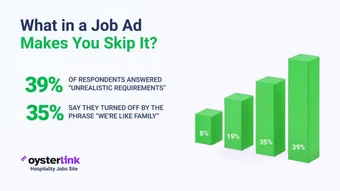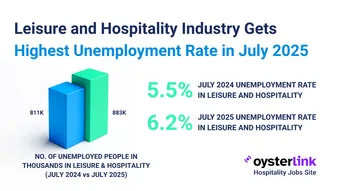Miami, FL – October 30, 2025 – As the U.S. government shutdown continues, OysterLink warns that the current economic climate could make 2025’s shutdown more damaging to the industry than the one in 2018.
In 2018, the restaurant industry was enjoying robust growth. Restaurants had just added 41,000 jobs in December, giving the industry a financial cushion to weather temporary disruptions.
By contrast, 2025 is starting from a position of weakness. Restaurant staffing has been essentially flat during the first eight months of the year, with fewer than 13,000 jobs added year-to-date, leaving operators with little room to absorb sudden drops in customer spending.
Employment Trends Signal Vulnerability
According to preliminary Bureau of Labor Statistics data, eating and drinking places added 11,000 jobs in August 2025, following a two-month period of essentially flat payrolls. Despite the slowdown, the overall demand for labor remained strong, with the hospitality sector hiring more than 800,000 workers over the last four months.
However, this growth has been offset by a higher-than-average number of employees leaving their jobs. Between May and July, approximately 715,000 hospitality workers quit, 150,000 more than the average over the prior 12 months. As a result, the restaurant workforce remains fragile.
Segment and Regional Disparities
The limited-service restaurant segment, including coffee shops, quick-service, and fast casual outlets, has outpaced pre-pandemic employment levels, with snack and beverage bars 22% above February 2020 figures and quick-service restaurants 2.3% above. Full-service restaurants, however, remain 222,000 jobs (or 4%) below pre-pandemic staffing.
At the state level, employment recovery has been uneven. Mountain states such as Idaho (+17%), Utah (+15%), and Nevada (+13%) have exceeded pre-pandemic staffing, while Massachusetts, West Virginia, and Maryland remain 4%–5% below their pre-pandemic levels.
What a Shutdown Could Mean for Restaurants
A prolonged government shutdown threatens to immediately impact restaurants in several ways:
- Reduced consumer spending: With federal workers temporarily out of work and overall consumer confidence fragile, restaurants could see traffic decline, particularly in areas with high concentrations of government employees.
- Staffing challenges: Any additional strain on hiring systems or verification services could further limit operators’ ability to fill open positions.
- Financial vulnerability: Restaurants entering a shutdown without a staffing or financial buffer may have to reduce hours, delay expansion, or even consider temporary layoffs.
“Unlike 2018, the industry has no cushion to absorb shocks. Any slowdown in spending could quickly force restaurants to make difficult operational decisions,” said Milos Eric, co-founder and general manager at OysterLink.
Even with these challenges, the restaurant sector has maintained a workforce above pre-pandemic levels overall, a testament to the industry’s resilience. But as the shutdown continues, operators are bracing for the first real test of that resilience in 2025.
About OysterLink
OysterLink is a job platform for restaurant and hospitality professionals with over 400,000 monthly visitors. OysterLink connects talent with opportunities across the U.S., including the top-paying part-time bartender jobs in Miami and part-time baker jobs in Miami.
The platform also offers trend reports, expert insights, and interviews with leaders in hospitality. To explore more data-driven insights or post a job that works for today’s talent, visit www.oysterlink.com.
Media Contact
Ana Demidova
[email protected]
About the Data: The analysis uses Bureau of Labor Statistics employment data from 2018, 2019, and 2025, focusing on eating and drinking establishments, which employ roughly 80% of the U.S. restaurant workforce.
Want more articles like this straight to your email? Make sure to create an OysterLink account and join our newsletter.







Loading comments...